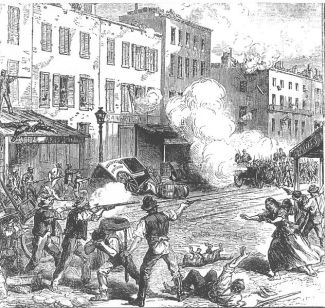 U.S. President Abraham Lincoln‘s Emancipation Proclamation on New Year’s Day has galvanized much of the Northern population, especially in New York City — with one exception: working class immigrants.
U.S. President Abraham Lincoln‘s Emancipation Proclamation on New Year’s Day has galvanized much of the Northern population, especially in New York City — with one exception: working class immigrants.
In particular, since Lincoln’s 1860 election Irish and German immigrants had been warned by the Democratic party that the Republicans were intent on emancipating African slaves, who then would flee North and compete with immigrants for jobs. Knowing the potential for Northern unrest, the Southern press reinforced Northern Democrats’ message. The Emancipation Proclamation vividly reinforced immigrants’ fears.
Then came the March 1863 draft laws, of which blacks (as non-citizens) were exempt and wealthy white men could exempt themselves by paying a $300 commutation fee. Northern Democrats and the Southern press intensified the rhetoric, charging that the U.S. government valued blacks over the working white class in the war to free blacks.
Now, two days ago, New York City’s conscription lottery began. Quietness initially pervaded the city. But this morning, a Monday, all hell breaks loose.
Rioters, comprised largely of immigrants, initially attack military and government buildings. Then they move against the city’s blacks. With the number of rioters totaling in the thousands, in the afternoon they loot and burn the Colored Orphan Asylum on Fifth Avenue.
For three more days the riots, the largest civil insurrection during the war, rage. Many of the city’s black-owned properties are destroyed, as well as many businesses catering to blacks.
On Tuesday night, the second day of rioting, the rioters attempt to burn the African American Antioch Baptist Church in Harlem on Fifth Avenue and 125th Street, “but were frustrated by the vigilance of the officers and specials” of the Twelfth Precinct.
The New York militia and some federal regiments are ordered to the city to suppress the rioters, but are unable to restore order before over 100 blacks have been killed by the mobs, including some by lynching.
With military enforcement, the riots come to an end on July 16. The draft resumes on August 19, and there are no further incidents.
Sources: Leslie M. Harris, “The New York City Draft Riots of 1863,” an excerpt from Harris’ In the Shadow of Slavery: African Americans in New York City, 1626-1863, University of Chicago Press, 2003 (link); New York City Draft Riots (link) and (link); David M. Barnes, The Draft Riots in New York, July, 1863: The Metropolitan Police, Their Services During Riot Week, Their Honorable Record, New York: Baker and Godwin, 1863, p. 53 (link); Image, the Illustrated London News (link)


